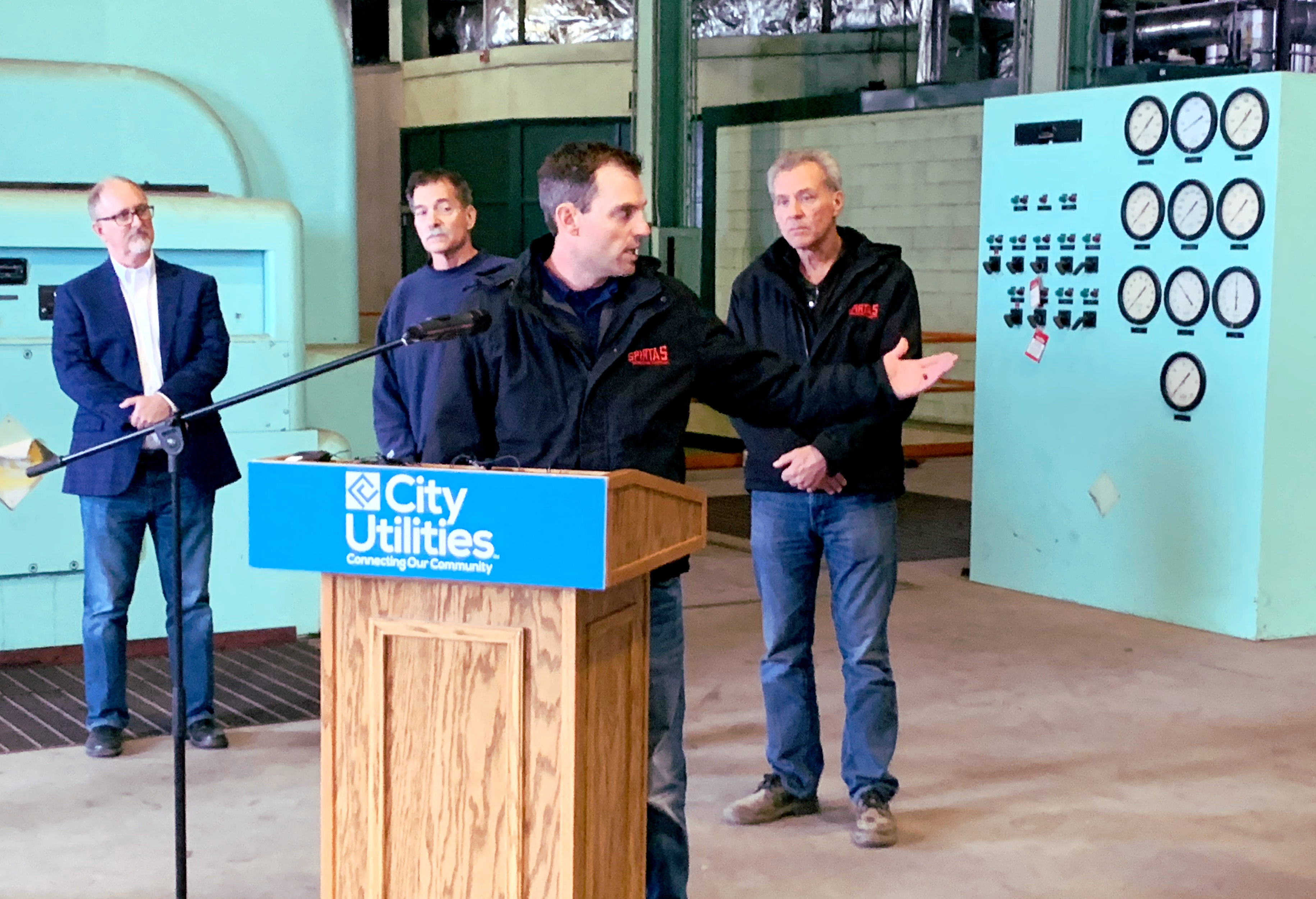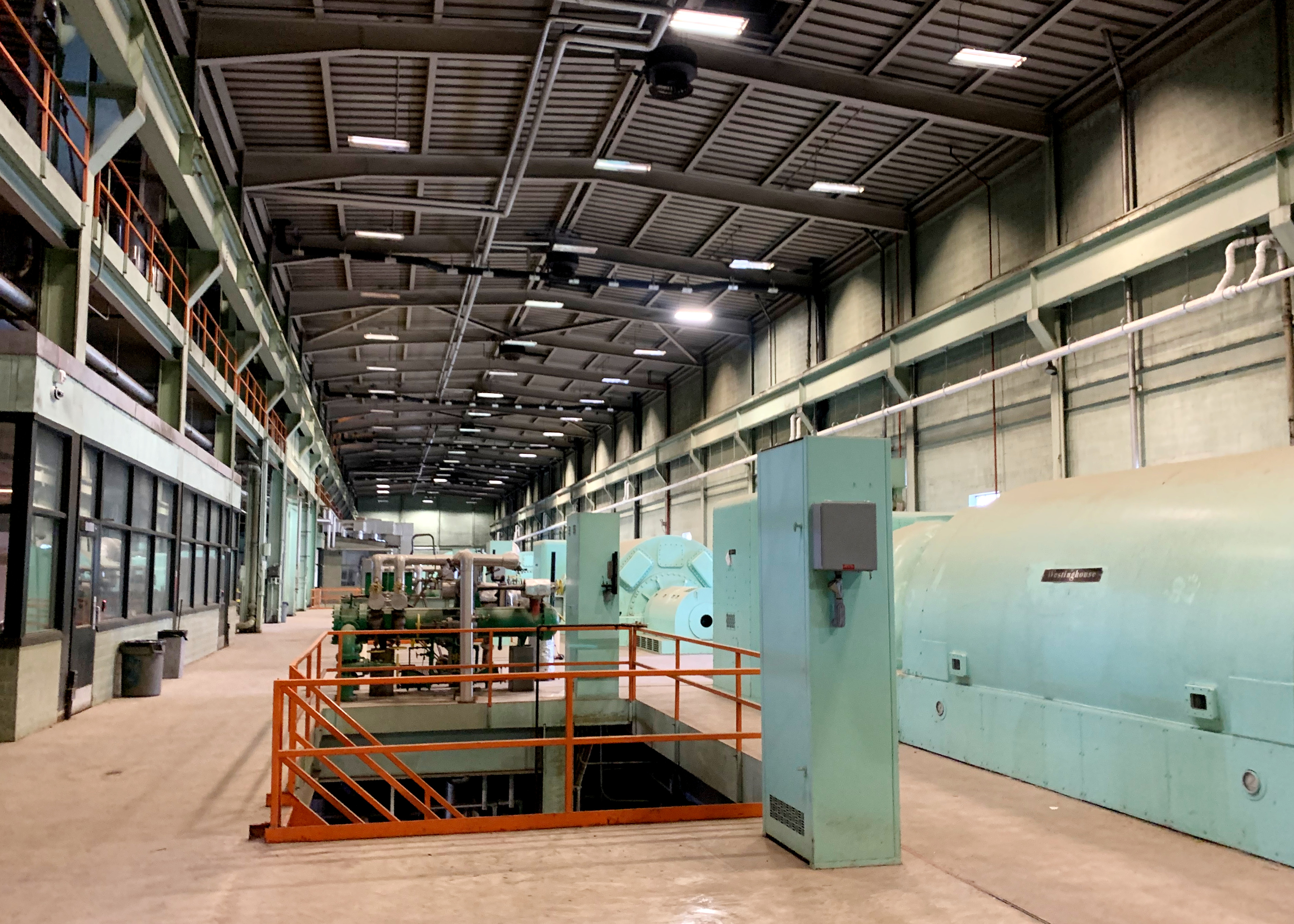Summary
There is more to demolishing the chimneys at a power plant than 300 pounds of explosives and shouts of “Yee-Haw!” Stakeholders explain the safety and environmental concerns tied to the implosion of four exhaust stacks at the City Utilities power plant at Lake Springfield.
The implosion of four chimneys at the James River Power Station on Lake Springfield will be a spectacle for anyone who drives out to see it, or watches the streaming footage from the comfort of home.
Saturday’s main event will take a matter of milliseconds, but months of careful planning have gone into a climactic moment in 65 years of power generation. Springfield City Utilities hired two contractors to safely take down four flue-exhaust stacks at the power plant on Feb. 19.
It was important to share the moment with the community, City Utilities President Gary Gibson said at a briefing held inside the James River Power Station on Feb. 17, about 48 hours before the booms.
“We know just because this has been an icon of Springfield since 1957 that the public would be interested in seeing the chimneys come down, and so we really — as we were doing our planning — thought that we needed to make a safe space for the public to be able to come out in a controlled manner,” Gibson said.
Spirtas Wrecking Company General Superintendent David Gaines explained that the outer shells of the stacks are made from concrete, and the interior is lined with brick. There is no insulation on the inside of the stacks, which means there should not be asbestos or other potentially hazardous insulating material on the inside of the chimneys.
“It’s just masonry brick built from the ground up,” Gaines said.
Why care?
Many of us are fascinated by watching large-scale demolitions, but there are plenty of potential hazards that come with taking down a massive tower made of concrete and brick.
Insulated steel ducts, which were possibly insulated with material that includes asbestos, have been disconnected and removed from the stacks in the process that has been going on for the last four months.
“We started that back in November and it’s taken us to this point to tear down all of the old pollution equipment, all of the old (induced draft) fans, everything that was wrapped around the stacks, that went into the stacks, that went into the boilers,” Gaines said. “There were separations made at the boilers to bring that material down safely and not damage anything at the building.”
Persons within 3-5 miles of the power plant will be able to hear the sound of the implosion and potentially feel a percussive effect.
While keeping bricks and concrete out of Lake Springfield should not be a challenge, the demolition contractor does have to work around an active power plant site where power is still being generated. Anything within range that must be preserved is what Gaines called “save assets,” which the blasts are engineered not to harm.
“We’ve got the live building to the north, we’ve got the natural gas turbines to the east, so there are some save assets in the area that we’re going to be very mindful of; it’s part of the plan,” Gaines said.
After the dust settles

Gaines said that the City Utilities demolition has the added challenge of making the implosion viewable to the public, and also keeping everyone at least 1,000 feet away from the stacks.
Streets around the power plant, including Evans Road and Kissick Avenue, will be closed at 8:30 a.m. on Saturday.
Before the stack implosion, work crews also took down the coal conveyor system in the coal yard, and are in the process of removing the underground system that took coal from the yard into the power plant for burning.
The conveyors ran through an underground tunnel system.
When the concrete and brick chimneys come down, the material won’t be traveling very far from the spot where it lands.
“It all gets processed on-site, and what I mean by processed is downsized to a certain spec,” Gaines said.
The concrete and brick will be broken down into pieces that are small enough to be moved. Any metal rebar is removed. The material is considered to be clean enough that it won’t need to be transported to a U.S. Environmental Protection Agency-approved disposal site. It will stay on the James River Power Station property.
“There is no trash to speak of at that point. There is no insulation, so we would just take the clean concrete when it’s down to size, and we would take it over and backfill the underground tunnels that had the old conveyor systems in them,” Gaines said.
Once the pieces of the stacks are used to backfill the old conveyor tunnels, the tunnels will be capped and covered with soil and grass.
When it comes to coal-fired power, fly ash is a byproduct of concern. The U.S. Environmental Protection Agency defines fly ash as “a very fine, powdery material composed mostly of silica made from the burning of finely ground coal in a boiler.”
Some people are concerned about the potential impact on the environment that demolishing the chimneys could have. Members of the White River Group of the Missouri Sierra Club raised concern that the stacks could contain asbestos.
Louise Wienckowski is the chairperson for the local Sierra Club group and said that she felt a little bit better about the risk of asbestos exposure after attending an Ozarks Clean Air Alliance meeting that had City Utilities staff members in attendance.
“They have put out assurances that they have put up netting and fencing and they are going to have misters blowing through the air during the implosion that should settle the particles,” Wienckowski said. “People are afraid it could drift, and it’s hazardous, it’s toxic.”

(Photo by Rance Burger)
In addition to asbestos, Wienckowski said that coal ash being carried on the wind is a concern.
“There certainly could be residue from burning coal, which they did for years. Coal has arsenic, mercury and a number of other chemicals in the coal ash that we have known about for years,” Wienckowski said.
The Sierra Club has chapters in all 50 U.S. states. It generally promotes sustainable energy practices and opposes the use of coal.
“We in the Sierra Club have always been skeptical about that, and have always been concerned and worried,” Wienckowski said. “Utility companies are not always honest, and they don’t always do the right thing.”
Wienckowski added that the Sierra Club has long been skeptical about City Utilities’ practice of using the coal yard at the James River site and the practice of transporting coal through underground tunnels.
Gaines said that there is minimal concern for coal ash or fly ash with the stack demolition project, because the majority of the coal ash has been removed from the chimneys, which have not been used since 2017. The demolition contractor also takes steps to reduce air pollution at the moment the explosives detonate and the structures fall.
“The fly ash has been removed out of the stacks. The dust that comes from the implosion itself is minimized with dust misters. You’ll see them out there the day of [the implosions] running. They are very large,” Gaines said.
Spraying the demolished material with water helps reduce the amount of dry dust that leaves the power plant site and affects nearby land. Stone quarries use similar practices to reduce the amount of material that flies into the wind onto nearby properties. If you have ever been to a ski resort or seen artificial snow-making machines, they have a similar appearance to an industrial dust mister.
There will still be some dust from mortar and grout on the inner brick lining of the stacks.
Tom Greiwe, president of Dem-Tech and controller of the implosion, explained that the demolition is regulated by the federal Bureau of Alcohol, Tobacco, Firearms and Explosives, the Missouri State Fire Marshal’s Office, the city of Springfield and the Springfield Fire Department.
Future development on Lake Springfield

The James River Power Station was shut down in 2018. The power plant started generating electricity with five turbine units in 1957. Some of the plant’s boilers used coal, while others used natural gas. Three of the units went offline in 2010. The flue stacks are among the last structures on the property scheduled for demolition.
Some parts of the power plant are still being used and are suitable for future use. According to a statement from City Utilities, office space, electrical substation equipment and two natural gas combustion turbines will remain on site.
“This site has generated power for our community for the last 65 years, and still will,” Gibson said. “We have two combustion turbines, natural gas jet engines that are sitting out there that we use when they are called upon to generate power for our community and the region, and those continue to be in service.”
On Feb. 10, the federal Economic Development Administration (EDA) announced that Springfield would receive an $800,000 grant to study the redevelopment of Lake Springfield following the removal of the power plant. The grant is funded through the $300 million Coal Communities Commitment through the American Rescue Plan Act.
Springfield will be required to meet an 80-20 match requirement, which means $200,000 in local funding will be required to study the site and propose solutions for its development. The Hatch Foundation, a Springfield community enrichment organization formed in 2019, contributed $100,000 to the study. Springfield City Utilities will contribute $60,000, and the Springfield Environmental Services Department will pay $60,000.
Want to see it go down?
Date: Saturday, Feb. 19, 9 a.m.
Surrounding roads, including Evans Road and Kissick Avenue, will be closed at 8:30 a.m.
Parking sites are south of the power plant off of Kissick Avenue, or in a paved section of Lake Springfield Park to the north of the power plant. These are the only two areas where public viewing of the implosion is permitted.
No one is allowed within 1,000 feet of the stacks
Parking space will be limited to the public.
Public drone flight is prohibited. The power generation site is a no-fly zone.
Watch from home: https://www.facebook.com/cityutilities.net/

